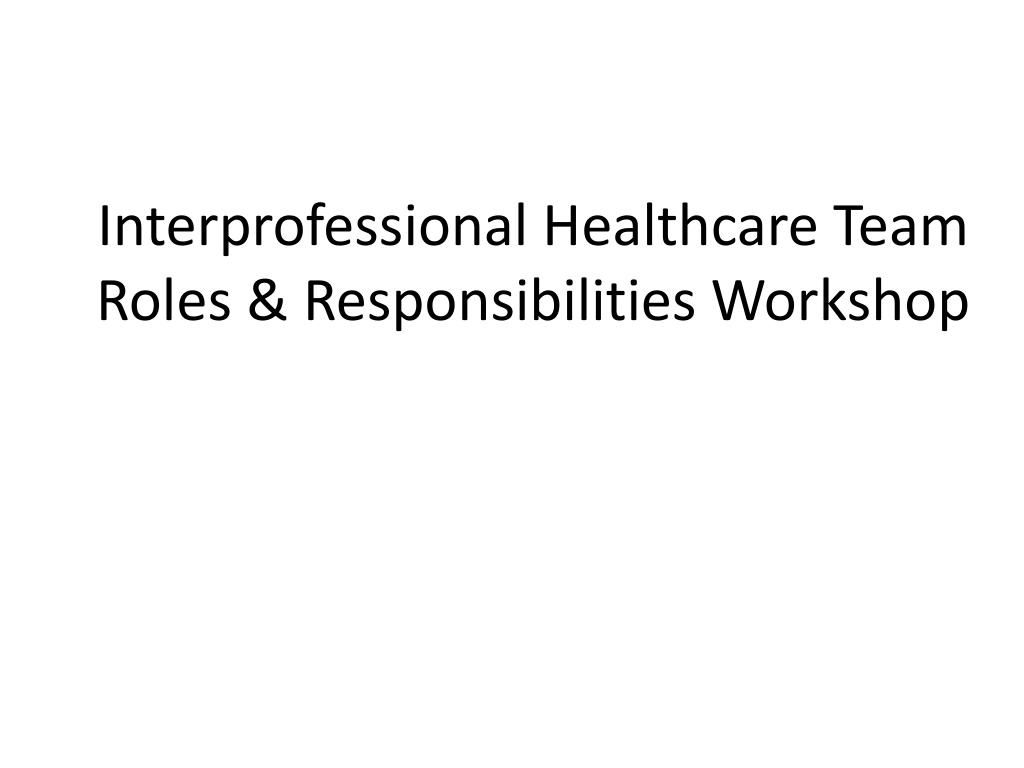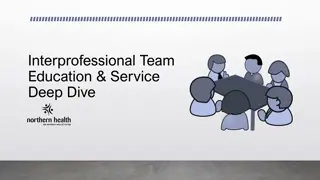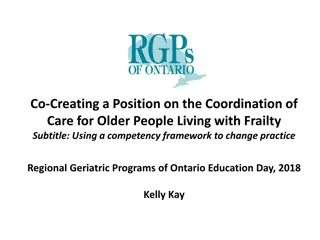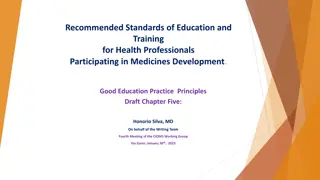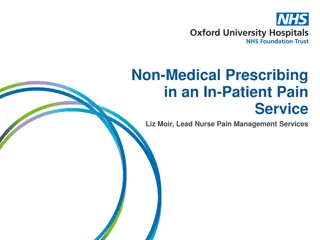Understanding Interprofessional Healthcare Teams
Explore the roles and benefits of interdisciplinary healthcare teams in various clinical settings. Learn about team members, consultation protocols, and models of care for effective patient outcomes. Discover real-life examples and outcomes from studies on interprofessional care.
Download Presentation

Please find below an Image/Link to download the presentation.
The content on the website is provided AS IS for your information and personal use only. It may not be sold, licensed, or shared on other websites without obtaining consent from the author. Download presentation by click this link. If you encounter any issues during the download, it is possible that the publisher has removed the file from their server.
E N D
Presentation Transcript
Interprofessional Healthcare Team Roles & Responsibilities Workshop
Objectives Identify 5 members of the interprofessional healthcare team in the ambulatory setting Identify when to consult interprofessional healthcare team members in the ambulatory setting Describe the role of at least 5 members of the interprofessional healthcare team in the ambulatory setting
Traditional Model of Care Doctor Patient
Interprofessional Model of Care Pharmacists Social Work Psychologists Family MD/DO Physical therapy Patient Nurse practitioner Caregivers Nurses Occupational therapy Speech & language therapy Registered dietitian
Models of Interprofessional Care There are some established interprofessional care models: Examples: Skilled nursing facilities, rehab facilities, anticoagulation clinics, some heart failure clinics, some geriatric clinics Often, physicians are the gate keeper of the services provided by other providers. Examples: Most primary care clinics and subspecialty clinics The more you know about interprofessional providers, the more likely you will be to work effectively with them
Interprofessional care benefits patients Randomized controlled trial Patients: 128 pts in VA hospital in TN, >65 yrs Intervention: 2 years of outpatient interdisciplinary care (PCP, SW, APN, psychologist) vs. standard ambulatory care Results: Intervention group had: Less IADL impairments Less depression Better life satisfaction Better MMSE scores Smaller increases in # of clinic visits Burns, R et al. Interdisciplinary geriatric primary care evaluation and management: two-year outcomes. J Am Geriatr Soc, 2000
Interprofessional Workshop Licensed Clinical Social Worker Physical Therapist Physician Patient Speech Language Pathologist Pharmacist Registered Dietitian Nutritionist
Interprofessional Workshop Licensed Clinical Social Worker Physical Therapist Physician Patient Speech Language Pathologist Pharmacist Registered Dietitian Nutritionist
Physician: Training Training 4 years medical school (allopathic or osteopathic) Med school length may vary at international schools (optional) additional degrees (PhD, MPH, JD, DDS) (required) Internship/Residency (optional) Fellowship(s) (optional) Board-certification Testing USMLE Step 1, Step 2 CS, Step 2CK, Step 3 Board exams Continuing Medical Education
Physician: Role Establish: Diagnosis Workup Management Consult interprofessional providers Mrs. S: weight loss, unsteady gait, memory Mr. S: right shoulder pain, caregiver stress, h/o bariatric surgery
Interprofessional Workshop Licensed Clinical Social Worker Physical Therapist Physician Patient Speech Language Pathologist Pharmacist Registered Dietitian Nutritionist
Pharmacist Training: Pharm D (usually 4 years post-grad) May do a residency 1st year usually general 2nd year usually specialty Role: To achieve positive outcomes from the use of medication which improves patients' quality of life with minimum risk. To help cure disease, eliminate or reduce symptoms, arrest or slow a disease process, prevent disease; diagnose disease American Association of Colleges of Pharmacy. Role of a Pharmacist, 2009. Web. 23 Jun. 2016.
Pharmacist Services they provide: Selection of a specific drug and/or dose Evaluation and review of drug regimen including interactions, dosing Monitoring effects of drug therapy Patient and caregiver education Evaluation of medication usage and therapy American Association of Colleges of Pharmacy. Role of a Pharmacist, 2009. Web. 23 Jun. 2016.
Interprofessional Workshop Licensed Clinical Social Worker Physical Therapist Physician Patient Speech Language Pathologist Pharmacist Registered Dietitian Nutritionist
Registered dietitian nutritionists (RDNs) Training: Minimum of a bachelor s degree; course work accredited/approved by the Accreditation Council for Education in Nutrition and Dietetics (ACEND) Completed an ACEND-accredited supervised practice program; typically 6-12 months Pass a national exam from the Commission on Dietetic Registration Additional Certifications (examples) Nutrition support (CNSC) Pediatrics (CSP)
Registered dietitian nutritionists (RDNs) Role: Nutrition experts Typical services include: Evaluate and assesses nutrition status of patients Plan and initiate medical nutrition therapy for patients Educate and counsel patients and families on nutritional issues
Interprofessional Workshop Licensed Clinical Social Worker Physical Therapist Physician Patient Speech Language Pathologist Pharmacist Registered Dietitian Nutritionist
Speech Language Pathologist Training: Master s, Doctoral degree Role: In a medical setting assess, diagnose, treat and help to prevent oral motor, swallowing, cognitive-linguistic, speech, and language disorders. They work with individuals affected by a neurological event/disease, head/neck cancer, or possibly debilitation related to an underlying medical disease process www.mayo.edu/mshs/careers/speech-pathology (Accessed 6/29/16)
Speech Language Pathologist Typical services: Use physical examination, instrumental technology, and standardized cognitive-linguistic and language tests to diagnose and guide treatment. Develop an individualized plan of care, tailored to each patient's needs. Eg. alternate nutrition or diet modification to reduce aspiration risk Educate patients, their family members and caregivers Develop a treatment plan unique to each individual's strengths and weakness www.mayo.edu/mshs/careers/speech-pathology (Accessed 6/29/16)
Interprofessional Workshop Licensed Clinical Social Worker Physical Therapist Physician Patient Speech Language Pathologist Pharmacist Registered Dietitian Nutritionist
Physical Therapist Training: Doctor of Physical Therapy (3 years post-grad) Optional specialty residency and fellowship training Role: Restore function, improve mobility, relieve pain, and prevent or limit permanent physical disabilities of patients suffering from injuries or disease. Determine patients ability to be independent and reintegrate into the community or workplace after injury or illness. Work to re-establish independence within the home if the patient is unable to participate in community mobility
Physical Therapist Typical PT services include: Functional training, therapeutic exercise, balance re- education for pts who have been immobilized, lack flexibility, strength, endurance, or balance Pain management in the form of: Pain Neuroscience Education Manual Therapy/Soft Tissue Massage Modalities Train patients and/or caretakers to use assistive and adaptive devices, such as crutches, prostheses, and wheelchairs. Teach patients and/or caretakers various exercises to do at home to expedite their recovery. Documentation of patient s progress with periodic examinations, and modification of treatments when necessary.
Interprofessional Workshop Licensed Clinical Social Worker Physical Therapist Physician Patient Speech Language Pathologist Pharmacist Registered Dietitian Nutritionist
Licensed Clinical Social Worker Training: Master s or doctorate degree 3000 (MSW) or 2000 (PhD/DSW) supervised clinical hours, and successful completion of licensing exam Role: Applies social work theory/methods to treatment & prevention of psychosocial dysfunction, disability, or impairment, including emotional and mental disorders
Licensed Clinical Social Worker Example of services provided: Mental health counseling and therapy Addictions Prevention/Treatment Domestic violence resources Hospice & palliative care Developmental disabilities Transitional care/care coordinators School social work Public welfare Child welfare Homeless family assistance Dementia & Alzheimer s Housing assistance Education about and access to community resources
In summary Patients benefit from care of interprofessional teams A patient s physician must often act as the gate keeper to assistance from other healthcare professionals Understanding the roles of various interprofessional team members will help you provide optimal care to patients
Workshop Logistics Next go to assigned small group breakout rooms Review the cases of Mr. S and Mrs. S Rotate rooms every 15 minutes
